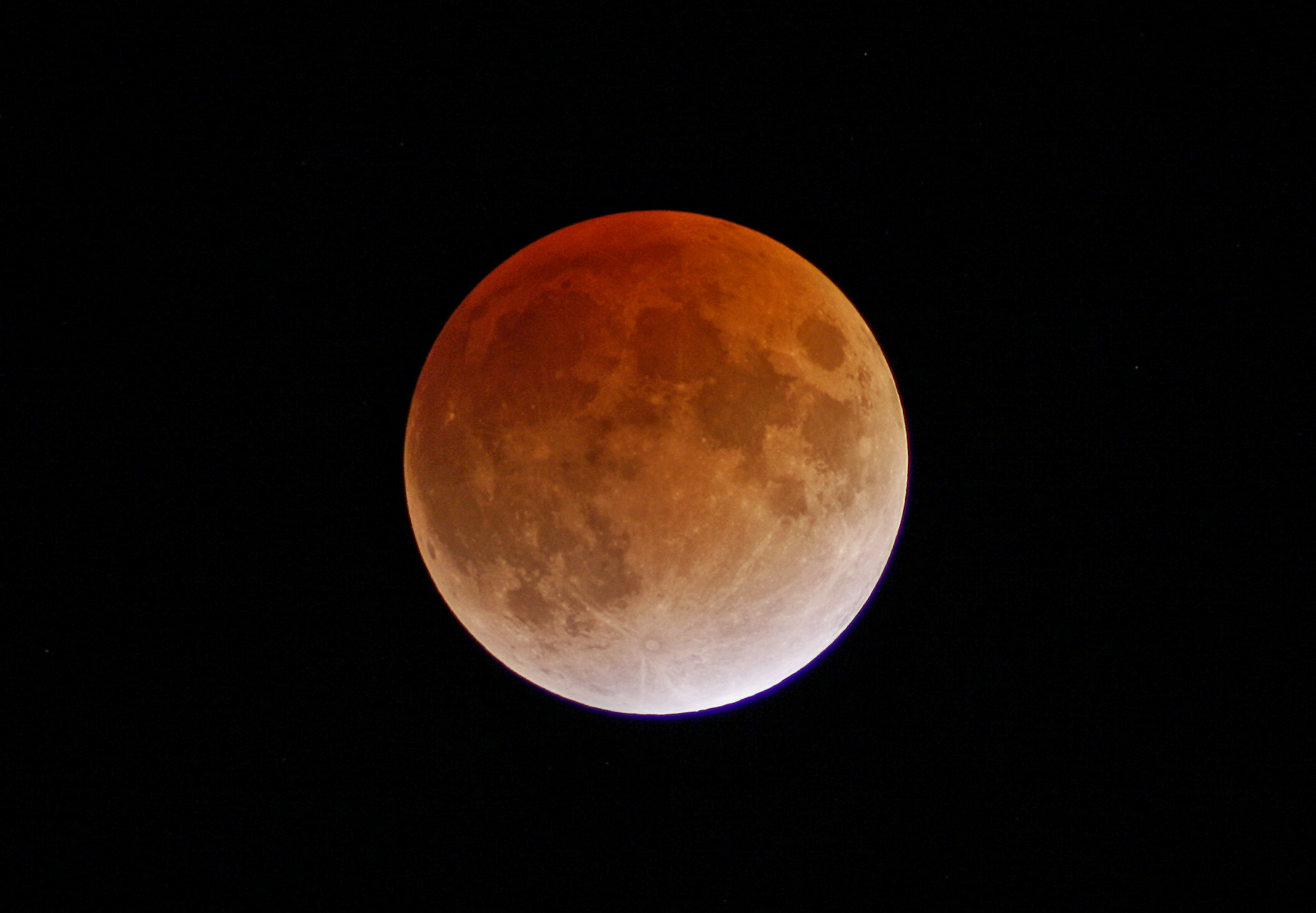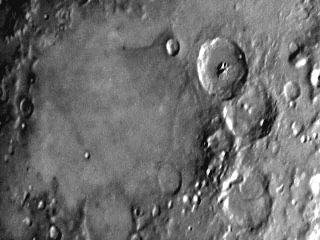
The Moon
Images: Fred Calvert / Cold Spring Observatory

Total Lunar Eclipse February 20, 2008 from Cold Spring Observatory
Cannon EOS 40D / Celestron 102MM F/5 Telescope / 2 second exposure
November 2003 Total Lunar Eclipse Nikon F3 Moon imaged with SBIG ST2000XM CCD Camera
 ````````````````
````````````````

Moon Images taken with SAC 7B CCD Camera
The Moon has fascinated mankind throughout the ages. By simply viewing with the naked eye, one can discern two major types of terrain: relatively bright highlands and darker plains. By the middle of the 17th century, Galileo and other early astronomers made telescopic observations, noting an almost endless overlapping of craters. It has also been known for more than a century that the Moon is less dense than the Earth. Although a certain amount of information was ascertained about the Moon before the space age, this new era has revealed many secrets barely imaginable before that time. Current knowledge of the Moon is greater than for any other solar system object except Earth. This lends to a greater understanding of geologic processes and further appreciation of the complexity of terrestrial planets.
On July 20, 1969, Neil Armstrong became the first man to step onto the surface of the Moon. He was followed by Edwin Aldrin, both of the Apollo 11 mission. They and other moon walkers experienced the effects of no atmosphere. Radio communications were used because sound waves can only be heard by travelling through the medium of air. The lunar sky is always black because diffraction of light requires an atmosphere. The astronauts also experienced gravitational differences. The moon's gravity is one-sixth that of the Earth's; a man who weighs 180 lbf (pound-force) on Earth weighs only 30 lbf on the Moon. (The equivalent metric weight (or force) is the Newton, where 4.45 Newtons equal one pound-force.)
The Moon is 384,403 kilometers (238,857 miles) distant from the Earth. Its diameter is 3,476 kilometers (2,160 miles). Both the rotation of the Moon and its revolution around Earth takes 27 days, 7 hours, and 43 minutes. This synchronous rotation is caused by an unsymmetrical distribution of mass in the Moon, which has allowed Earth's gravity to keep one lunar hemisphere permanently turned toward Earth. Optical librations have been observed telescopically since the mid-17th century. Very small but real librations (maximum about 0°.04) are caused by the effect of the Sun's gravity and the eccentricity of Earth's orbit, perturbing the Moon's orbit and allowing cyclical preponderances of torque in both east-west and north-south directions.
Four nuclear powered seismic stations were installed during the Apollo project to collect seismic data about the interior of the Moon. There is only residual tectonic activity due to cooling and tidal forcing, but other moonquakes have been caused by meteor impacts and artificial means, such as deliberately crashing the Lunar Module into the moon. The results have shown the Moon to have a crust 60 kilometers (37 miles) thick at the center of the near side. If this crust is uniform over the Moon, it would constitute about 10% of the Moon's volume as compared to the less than 1% on Earth. The seismic determinations of a crust and mantle on the Moon indicate a layered planet with differentiation by igneous processes. There is no evidence for an iron-rich core unless it were a small one. Seismic information has influenced theories about the formation and evolution of the Moon.
The Moon was heavily bombarded early in its history, which caused many of the original rocks of the ancient crust to be thoroughly mixed, melted, buried, or obliterated. Meteoritic impacts brought a variety of "exotic" rocks to the Moon so that samples obtained from only 9 locations produced many different rock types for study. The impacts also exposed Moon rocks of great depth and distributed their fragments laterally away from their places of origin, making them more accessible. The underlying crust was also thinned and cracked, allowing molten basalt from the interior to reach the surface. Because the Moon has neither an atmosphere nor any water, the components in the soils do not weather chemically as they would on Earth. Rocks more than 4 billion years old still exist there, yielding information about the early history of the solar system that is unavailable on Earth. Geological activity on the Moon consists of occasional large impacts and the continued formation of the regolith. It is thus considered geologically dead. With such an active early history of bombardment and a relatively abrupt end of heavy impact activity, the Moon is considered fossilized in time.
The Apollo and Luna missions returned 382 kilograms (840 pounds) of rock and soil from which three major surface materials have been studied: the regolith, the maria, and the terrae. Micrometeorite bombardment has thoroughly pulverized the surface rocks into a fine-grained debris called the regolith. The regolith, or lunar soil, is unconsolidated mineral grains, rock fragments, and combinations of these which have been welded by impact-generated glass. It is found over the entire Moon, with the exception of steep crater and valley walls. It is 2 to 8 meters (7 to 26 feet) thick on the maria and may exceed 15 meters (49 feet) on the terrae, depending on how long the bedrock underneath it has been exposed to meteoritic bombardment.
The dark, relatively lightly cratered maria cover about 16% of the lunar surface and is concentrated on the nearside of the Moon, mostly within impact basins. This concentration may be explained by the fact that the Moon's center of mass is offset from its geometric center by about 2 kilometers (1.2 miles) in the direction of Earth, probably because the crust is thicker on the farside. It is possible, therefore, that basalt magmas rising from the interior reached the surface easily on the nearside, but encountered difficulty on the farside. Mare rocks are basalt and most date from 3.8 to 3.1 billion years. Some fragments in highland breccias date to 4.3 billion years and high resolution photographs suggest some mare flows actually embay young craters and may thus be as young as 1 billion years. The maria average only a few hundred meters in thickness but are so massive they frequently deformed the crust underneath them which created fault-like depressions and raised ridges.
The relatively bright, heavily cratered highlands are called terrae. The craters and basins in the highlands are formed by meteorite impact and are thus older than the maria, having accumulated more craters. The dominant rock type in this region contain high contents of plagioclase feldspar (a mineral rich in calcium and aluminum) and are a mixture of crustal fragments brecciated by meteorite impacts. Most terrae breccias are composed of still older breccia fragments. Other terrae samples are fine-grained crystalline rocks formed by shock melting due to the high pressures of an impact event. Nearly all of the highland breccias and impact melts formed about 4.0 to 3.8 billion years ago. The intense bombardment began 4.6 billion years ago, which is the estimated time of the Moon's origin. (Text: CJ Hamilton)
LX 200 Telescope SBIG ST2000XM / CFW8 / A07 Cold Spring Observatory Control Room